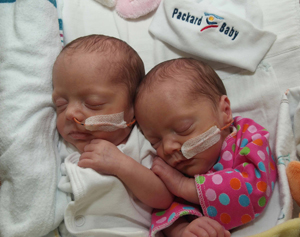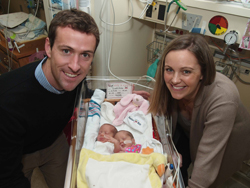January 14, 2013 - By Winter Johnson

Kate and Annie Carlson shared the same amniotic sac for 30 weeks. Monoamniotic twins account for less than 1 percent of all U.S. twin pregnancies. The condition poses risks, including cord entanglement, for the fetuses.
Allison and Kevin Carlson got to take home two great Christmas gifts from Lucile Packard Children's Hospital — a set of rare monoamniotic twins named Kate and Annie, delivered on Nov. 7 at just 30 weeks gestation.
Twins who share the same amniotic sac, a condition that occurs in less than 1 percent of all U.S. twin pregnancies, face serious risks — including cord entanglement, which can cut off the blood flow from the placenta to the fetus. With Kate and Annie, the girls' cords created a perfect but alarming knot and their heart rate was dropping, leading to an emergency cesarean delivery at Packard Children's.
"Having a set of monoamniotic twins can be dangerous and unpredictable," said Susan Crowe, MD, who led the delivery team and noted that around 20 percent of these twins die from complications due to sharing the same sac. "With no membrane dividing them, the obstetrician has to balance the risk of prematurity with the risk of a cord event. But, thanks to the excellent care our NICU gives our high-risk cases and preemies, we expect very good outcomes if we have to deliver them early."
As first-time parents, the Carlsons thought they were only having one baby, but were thrilled to learn at week 17 that Allison was pregnant with twins. While their excitement quickly turned to a bit of fear when they learned about the dangers involved with monoamniotic twins, they were comforted knowing that the Center for Fetal and Maternal Health at Packard Children's specializes in these and other types of high-risk pregnancies.

For Kevin and Allison Carlson, Christmas came early: Their twins were delivered Nov. 7, 10 weeks ahead of term. "Packard Children's really put us at ease with their experience and expertise," Kevin Carlson said.
Jane Chueh, MD, director of prenatal diagnosis and therapy, and the obstetrical team guided Allison from the day she arrived at Packard Children's in October through the long weeks leading up to the girls' emergency delivery — making sure that she got the rest and care needed to assist the day-to-day growth of the twins, and delay the need for delivery as long as possible.
Though the high-risk team at Packard Children's was hoping to get Kate and Annie to at least a Nov. 30 delivery date to minimize the risk of lung disease and other complications associated with prematurity, doctors determined on Nov. 7 that the twins' rapidly decreasing heart rate required they enter the world immediately — about 10 weeks before the babies would hit a full 40-week term. "Our doctors, nurses and neonatologists are able to deliver extraordinary care at a moment's notice for cases like this," Chueh said.
On one of the scariest days a new mom could ever imagine, "One of the nurses held my hand and spoke to me in a soothing voice as I was getting my anesthesia," Allison said. "She calmly walked me through the entire procedure."
Neonatologist William Rhine, MD, was among those monitoring the preemies once they were successfully delivered and arrived in the neonatal intensive care unit, where the babies — weighing in at just 3 pounds for Kate, and 3 pounds, 2 ounces for Annie — began life. "It was a testimony to the skill of the obstetricians to allow the twins to grow in the womb as much as they did, so that their lungs were able to mature," Rhine said. "They perfectly weighed the balance of being born early versus creating a heightened risk of cord compression and entanglement by letting them stay in utero."
Kate and Annie are already displaying their personalities, their parents say. Kate is the "calm one," and Annie the "wild woman," according to mom and dad. The happy parents took the girls home to a nursery decked out with plenty of pink.
Kevin is looking forward to the new year with his new daughters. "We're really grateful," he said. "Despite the chaos surrounding our delivery and pregnancy, Packard Children's really put us at ease with their experience and expertise, and it's one of the best holiday gifts a family could ever ask for."
About Stanford Medicine
Stanford Medicine is an integrated academic health system comprising the Stanford School of Medicine and adult and pediatric health care delivery systems. Together, they harness the full potential of biomedicine through collaborative research, education and clinical care for patients. For more information, please visit med.stanford.edu.